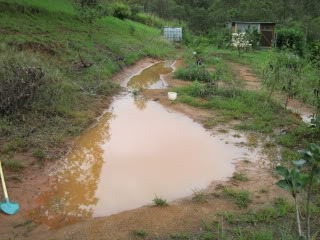Chris from Living at Gully Grove shares some excellent examples of using permaculture design principles to improve her property, as a response to my invitation to guest post about permaculture. If you have something to contribute that could help others learn how to use permaculture at their place, please send me an email eight.acres.liz at gmail.com, and I'll send you some more details.
A family of three (now four) left suburbia in 2007, to start life on five acres. We could only afford degraded bushland on slopes, which has proven to be a lesson in how natural systems work. The only way we could live harmoniously with the challenging terrain, was by implementing some clever permaculture designs. It's a constantly evolving process too. We dubbed our little patch “Gully Grove”, simply because gullies are the natural terrain here, and planting groves in them, are our solution to avoiding degradation.
Personally, I never wanted to be a Permaculture convert, but curiosity led me to explore it's potential. We were looking for different ways to interpret the landscape on our five acres. I wasn't sure if any of the strategies would work, but they certainly got me to question my understanding of managing natural energy for long-term permanency.
One thing that should top the list of defining permaculture though, is how it's primarily a design process. All the twelve principles of permaculture you will read about, are meant to start the design process of any garden (or space) you want to create. It's also an evolving process which is ready to adapt to feedback from the environment you've co-engineered with nature.
On our five acres, we've had to lean heavily on the use of swales to manage water flows over the land. Otherwise, water will run rapidly down the slope, taking a lot of soil and nutrients with it.
 |
| December 2010 – photo taken from our front verandah |
 |
| small pond and swale directs the water away from the slope |
 |
| 2012 – swale on right, cana lily bank on left (notice the cut green grass on the swale in a dry period?) |
Swales are not the only tool which can be used in a permaculture design process however. Like most people just starting to explore permaculture for the first time, chances are, you're already living in a permanent dwelling. You cannot change the main structure, but permaculture is a way to design the areas around it, to your own benefit.
Even though we live on acreage, I still utilise the covered verandah around my house. I garden in pots because its easier than gardening in the elements sometimes. I propagate by cutting, division and seed, all on my front verandah. I even get the occasional surprise, like this tomato growing in a pot I did not plant there.
Even though we live on acreage, I still utilise the covered verandah around my house. I garden in pots because its easier than gardening in the elements sometimes. I propagate by cutting, division and seed, all on my front verandah. I even get the occasional surprise, like this tomato growing in a pot I did not plant there.
 |
| A volunteer tomato |
I can garden in my pots year round, as they are living in a selected environment I can manipulate to my advantage. If they're not happy in a particular spot, I can always move them to a new one. If you're living on a small block of land in the city, plants are of tremendous value that can fit almost anywhere. You just need the right design to get you started.
 |
| Geraniums are hardy pot survivors, sheltering chives in the middle |
Deep Green Permaculture is another site which provides a great start for understanding permaculture, but it also houses a wealth of information for small scale gardens in urban settings.
Even though I've had a few years to test the permaculture design principles in my own backyard, I have to say, I'm constantly developing new appreciation for what I can learn. Permaculture helps me understand the landscape and the immediate human environment surrounding me, better. And I'm not even a full convert. I think I tend to dabble, and that's what works for me.
If you're interested in looking at the world a different way, then consider permaculture. There is plenty of free information on the internet, or borrow a book from the library. You can even purchase ebooks over the internet, or if you're really keen, pay to complete a course. Permaculture is in the public domain, how ever you choose to explore the subject. I haven't regretted dabbling in it myself.
Thanks so much for sharing Chris, what excellent practical examples and before and after photos that really show the power of good permaculture design to improve and make use of a difficult property. If you would like to comment or ask any questions of Chris, please visit her blog at Living at Gully Grove.


Homestead Barnhop 143
Simple Saturday's Bloghop
The Homeacre Hop 54
